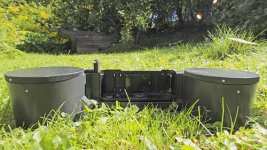Looking forward to the results Brett. My recently acquired 11E is looking for some variety beyond the 50/1.8 and I'm leaning towards the 28/3.5. Curious about that and the Kinoptic though I'd never afford one (or even the hood). The 90/2.5 also looks nice.
I'm about to build a 'contabag' (or the manual version technically) from an Alpa/M42 adapter and an old Contax/EOS adapter. The original part seems to be less available than a unicorn...
I have not made any decent images of the Angenieux 28mm f/3.5 yet, but certainly will—it is such an interesting-looking and beautifully made lens. Very classy in its silver finish. The control wheel for setting the aperture is also such an unusual feature. This one has both lens caps including the immaculate silver front one. I'll make a point of doing a few shots at different distances and apertures—after all, this is likely the only chance I'll ever have to see what they can do, and I'm keen to find out, too!
Cheers
Brett
As we have had visitors from interstate this week we planned a trip to one of Tasmania's most-loved national parks, today, Mount Field. I took the 11si along to shoot some black and white landscapes, and managed to knock off the roll of Acros 100 I started on Friday at above the snow line at Lake Dobson, so a roll of Agfa APX100 was loaded into it, because I'm not going to get another chance to shoot with these rare lenses any time soon, and I'm not done with them yet. No film images processed or scanned, yet, but here's another quick shot I grabbed with my phone, showing the ALPA sitting on a tripod wearing the Angenieux in front of Russell Falls. It's such a pretty looking lens: this photo doesn't do it justice at all. This wide angle is so beautifully put together and finished. It's a subjective point, of course, but I think it's the classiest 35mm lens I have ever handled. If it performs half as well as it looks, it's a winner.
Cheers,
Brett

Cheers,
Brett

Jerevan
Recycled User
Really interesting cameras - love the looks of the 6b and the 7.
Getting one of these with a lens would solve the "what camera should I use today" issue - one camera and one lens would be all I could ever afford!
Getting one of these with a lens would solve the "what camera should I use today" issue - one camera and one lens would be all I could ever afford!
Well, strangely, that was part of the appeal of the 7 for me. Occasionally I get those days where I can't decide whether I want to use a rangefinder or an SLR. With the 7, I don't have to, because it's both!Really interesting cameras - love the looks of the 6b and the 7.
Getting one of these with a lens would solve the "what camera should I use today" issue - one camera and one lens would be all I could ever afford!
Cheers
Brett
Sorry for not replying sooner. Thanks for sharing these images made with another ALPA. It's great to know that there is another member using them here!I was lucky to buy Alpa 6b few months ago, and finally it's back from CLA. Done some test shots, and while Switar is very pleasing, using the camera is trully unique (awkward), some kind of je ne sais qoui.

Not a shelf queen and I'm gonna use it properly (with some chromes).
Some test shots on TMax:



Cheers,
Brett
Here are a few more images of one of the 11si models. This one has the black crinkle paint finish and is a tidy example in good working condition. The macro version of the Kern 50mm Switar (the later f/1.9 Macro-Switar is seen here) can rotate its focus ring approximately 2 & 2/3 turns from infinity to closest focus. As seen in some of the images it can still rotate a bit further towards the closest setting: it's not quite at minimum distance in these shots.
The depth of field indicator system may well be unique to these lenses? As the f stop is selected, small brass or copper strips progressively appear, or disappear, beneath a series of small holes drilled through the lens barrel to indicate the current aperture. You can see the two gold-coloured indicators for the maximum f/1.9 opening that is selected, clearly visible in the fifth image, as opposed to the adjacent holes for the smaller apertures. From memory, I believe ALPA called this DOF scale "Visifocus".
It's very impressive to adjust the aperture ring and see the dots change colour as the f stop is decreased or increased, but I doubt it's really as usable as a conventional DOF scale. And, whilst I'm not easily frightened by working on fairly complex cameras or lenses, I do confess that, the complexity of the Visifocus scale, together with its exceptionally long travel helical, would make prospect of having to strip down a Macro-Switar fully, rather frightening!
The chrome rotating switch with black arrow visible at the end of the lug on the lens mount that houses the release plunger is an auto/manual aperture control. It's essential to set this if a self timer exposure is being made unless the lens is being shot wide open. Finger pressure on the release plunger is what actuates the stop down system, akin to some Exakta SLRs. But without a finger on the plunger, the timer will not close the aperture automatically at the moment of exposure, hence, it has to be manually locked down via the switch.
The chrome sliding release switch on the body near the body release may be set to lock the release system, in which case, depth of field and or light metering (it's a stop down metering system) can be checked simply by pushing the lens plunger down without fear of inadvertently firing the shutter in the process. It has three positions and can also be set to stop down and meter, before slight additional pressure will then trip the shutter.
If the Macro-Switar is used on an older ALPA body without a body release slider lock, rotating the lens aperture switch, as well as facilitating correct timer exposures, will also enable the depth of field to be checked without firing the shutter, if desired.
Many lenses made in the larger ALPA bayonet used from the 4 onwards have a clip system for fitting filters or lens hoods. Filters click into a groove at the front of the lens using a spring circlip on their rear mating flange as do lens caps. Lens hoods have a stronger clip that has to be depressed by thumb and finger to retract it out of the way before the mount will clear the lens. This makes it impossible for a hood to fall off accidentally as whilst it will rotate freely around the lens, it is positively locked into the groove and will not remove unless the clip is manually depressed. It's so simple and effective one wonders why more manufacturers didn't use it. Perhaps it cost more to make? As a bonus many lens hoods can be reversed onto the lens and clipped securely around the barrel for easier stowage and lens protection. See the final image of the 11si in its original packaging as a case in point.
Like certain Rollei 35 models no external battery hatch mars the appearance of the 11si. On the bottom of the body casting on the rewind side, a small sliding cover complete with sticker advising the original battery specification may be slid across to permit battery installation or replacement. It's visible in the image with the back removed from the body just to the left of the film gate.
Unusually for any camera that's not a Zeiss Ikon or an Exakta, the take up spool can actually be completely removed from the body if desired. It's not permanently installed into the body, as it's retained in place by a simple leaf spring underneath it. This may be gently extended enough to slide the spool out of engagement with its drive lugs in the socket at the top of the wind side housing. But why? Unlike a Contax or Exakta the ALPA design doesn't lend itself easily to cassette to cassette loading. Perhaps it facilitates the use of a bulk film magazine, or permits the leader to be attached to the spool prior to inserting the cassette? Certainly, I had no trouble loading the 11si with spool in its proper place though as a regular Contax shooter, juggling camera back and body whilst inserting leader and cassette comes easily. It is just the way ALPA made them. Personally I'm not inclined to criticise this peculiarity, because I will need to dismantle an ALPA 7 at some stage, and, it is certainly going to make it that much easier to dismantle that part of the camera, than a typical take up spool installation...
Harking back to 1960s design cues, a top deck light meter readout is included underneath the accessory shoe, of all places. The small lever at rear covers or exposes a little window inside which the three illuminated lights for "Under" (Red), "Correct" (Green), or "Over" (Yellow) visible within the main viewfinder are duplicated, in order to permit metering without the camera to one's eye—a potentially very useful feature for tripod photography—particularly for those of us with bad necks like myself, who finds hunching down to peer though a low eye level finder a real chore at the best of times.
All this is made foolproof by Alpa's innovative third meter cell, that is included specifically to detect any light entering via the viewfinder eyepiece, and subtract it from the total light received through the lens by the more conventional pair of cells mounted on the prism. So simple, and so effective. If only the camera also featured open aperture metering, as well! And, should you be wondering, here, if an 11si is a scandalously expensive (no 35mm camera of its time, was more expensive on the UK market than the 11si according to photographic author and former Alpa dealer, Ivor Matanle) and eccentric confection of sensational build quality, highly innovative, and downright archaic design features—you'd be absolutely right.
Near the rewind knob (which, incidentally, extends upwards and outwards on twin struts, to promote rapid rewinding) there is a small plate, typically finished in silver or gold, on which the letters "K.M." are immaculately engraved. These are the initials of the original owner of this Alpa 11si. Pignons would (at a price) make you an Alpa to your precise specifications—even to the extent of supplying non-standard format sizes such as extra-long film gate, or shorter than 36mm length or other variations. As late as the 1970s they were still prepared to (and did) manufacture long obsolete models such as the Alnea 7 first introduced in the early to mid 1950s on special request. Engraving the fortunate buyer's initials onto that small plate attached to the top of their flagship model was no doubt a reflection of the pride they took in making it as much as the owner's pride of having such a rare and exclusive model.
There are many more unusual details that make photography with an ALPA 11si no better or (perhaps) worse than with more prosaic cameras, but, without doubt, different, to almost any other make.
Cheers,
Brett
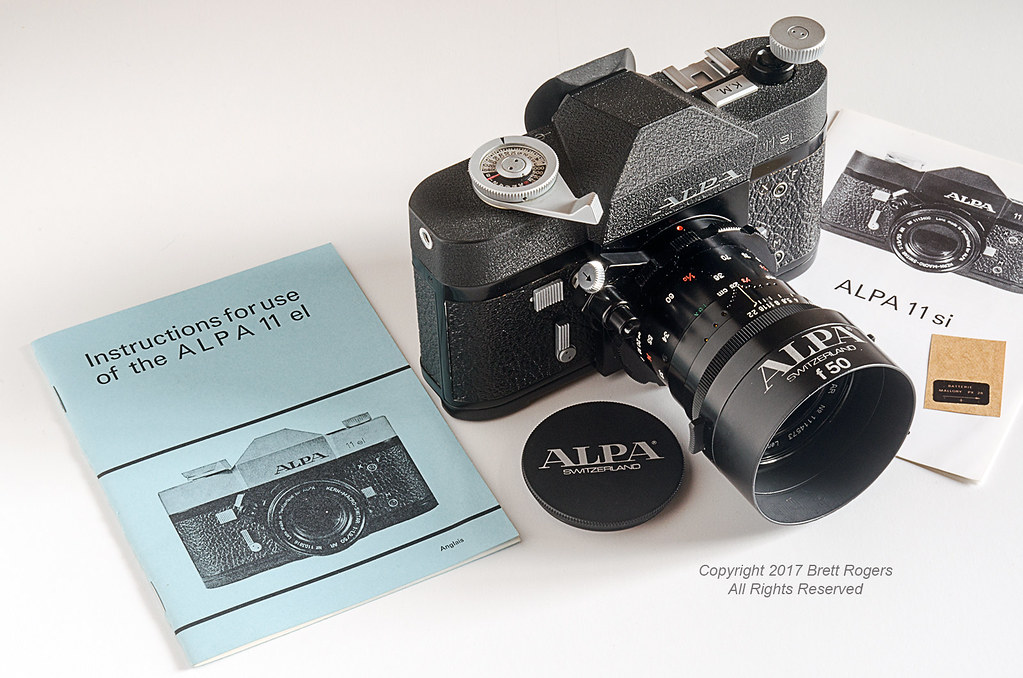

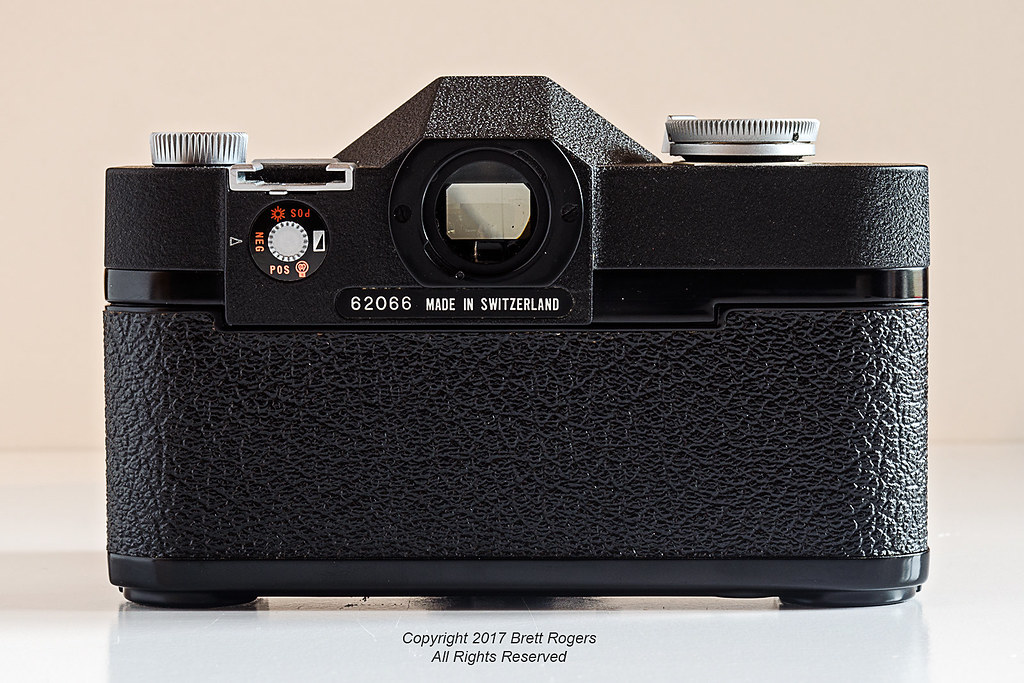



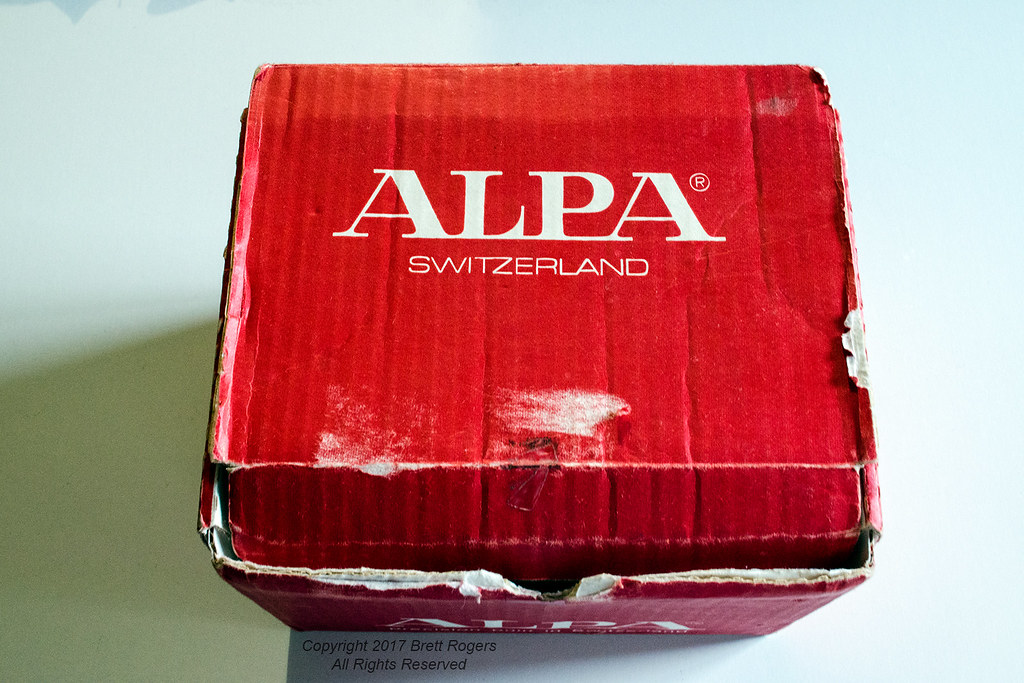
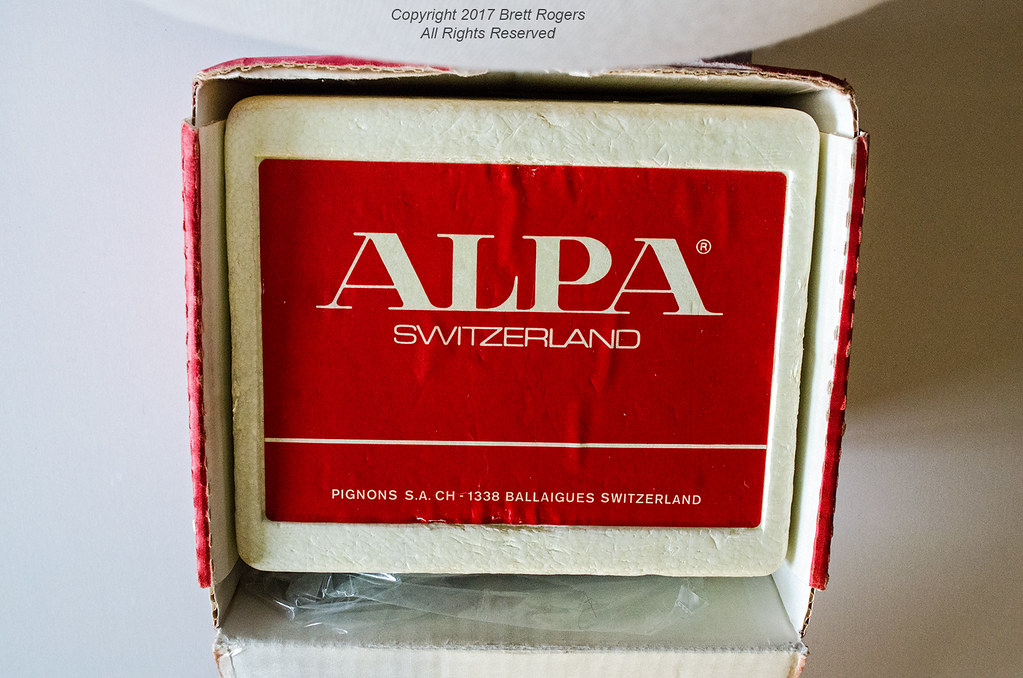
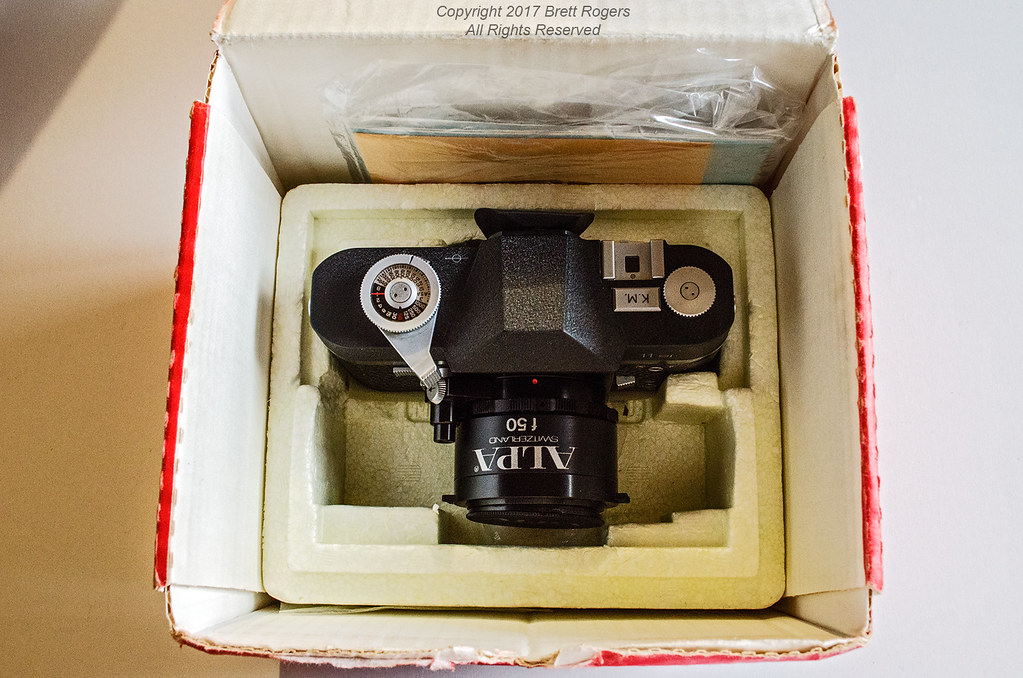
The depth of field indicator system may well be unique to these lenses? As the f stop is selected, small brass or copper strips progressively appear, or disappear, beneath a series of small holes drilled through the lens barrel to indicate the current aperture. You can see the two gold-coloured indicators for the maximum f/1.9 opening that is selected, clearly visible in the fifth image, as opposed to the adjacent holes for the smaller apertures. From memory, I believe ALPA called this DOF scale "Visifocus".
It's very impressive to adjust the aperture ring and see the dots change colour as the f stop is decreased or increased, but I doubt it's really as usable as a conventional DOF scale. And, whilst I'm not easily frightened by working on fairly complex cameras or lenses, I do confess that, the complexity of the Visifocus scale, together with its exceptionally long travel helical, would make prospect of having to strip down a Macro-Switar fully, rather frightening!
The chrome rotating switch with black arrow visible at the end of the lug on the lens mount that houses the release plunger is an auto/manual aperture control. It's essential to set this if a self timer exposure is being made unless the lens is being shot wide open. Finger pressure on the release plunger is what actuates the stop down system, akin to some Exakta SLRs. But without a finger on the plunger, the timer will not close the aperture automatically at the moment of exposure, hence, it has to be manually locked down via the switch.
The chrome sliding release switch on the body near the body release may be set to lock the release system, in which case, depth of field and or light metering (it's a stop down metering system) can be checked simply by pushing the lens plunger down without fear of inadvertently firing the shutter in the process. It has three positions and can also be set to stop down and meter, before slight additional pressure will then trip the shutter.
If the Macro-Switar is used on an older ALPA body without a body release slider lock, rotating the lens aperture switch, as well as facilitating correct timer exposures, will also enable the depth of field to be checked without firing the shutter, if desired.
Many lenses made in the larger ALPA bayonet used from the 4 onwards have a clip system for fitting filters or lens hoods. Filters click into a groove at the front of the lens using a spring circlip on their rear mating flange as do lens caps. Lens hoods have a stronger clip that has to be depressed by thumb and finger to retract it out of the way before the mount will clear the lens. This makes it impossible for a hood to fall off accidentally as whilst it will rotate freely around the lens, it is positively locked into the groove and will not remove unless the clip is manually depressed. It's so simple and effective one wonders why more manufacturers didn't use it. Perhaps it cost more to make? As a bonus many lens hoods can be reversed onto the lens and clipped securely around the barrel for easier stowage and lens protection. See the final image of the 11si in its original packaging as a case in point.
Like certain Rollei 35 models no external battery hatch mars the appearance of the 11si. On the bottom of the body casting on the rewind side, a small sliding cover complete with sticker advising the original battery specification may be slid across to permit battery installation or replacement. It's visible in the image with the back removed from the body just to the left of the film gate.
Unusually for any camera that's not a Zeiss Ikon or an Exakta, the take up spool can actually be completely removed from the body if desired. It's not permanently installed into the body, as it's retained in place by a simple leaf spring underneath it. This may be gently extended enough to slide the spool out of engagement with its drive lugs in the socket at the top of the wind side housing. But why? Unlike a Contax or Exakta the ALPA design doesn't lend itself easily to cassette to cassette loading. Perhaps it facilitates the use of a bulk film magazine, or permits the leader to be attached to the spool prior to inserting the cassette? Certainly, I had no trouble loading the 11si with spool in its proper place though as a regular Contax shooter, juggling camera back and body whilst inserting leader and cassette comes easily. It is just the way ALPA made them. Personally I'm not inclined to criticise this peculiarity, because I will need to dismantle an ALPA 7 at some stage, and, it is certainly going to make it that much easier to dismantle that part of the camera, than a typical take up spool installation...
Harking back to 1960s design cues, a top deck light meter readout is included underneath the accessory shoe, of all places. The small lever at rear covers or exposes a little window inside which the three illuminated lights for "Under" (Red), "Correct" (Green), or "Over" (Yellow) visible within the main viewfinder are duplicated, in order to permit metering without the camera to one's eye—a potentially very useful feature for tripod photography—particularly for those of us with bad necks like myself, who finds hunching down to peer though a low eye level finder a real chore at the best of times.
All this is made foolproof by Alpa's innovative third meter cell, that is included specifically to detect any light entering via the viewfinder eyepiece, and subtract it from the total light received through the lens by the more conventional pair of cells mounted on the prism. So simple, and so effective. If only the camera also featured open aperture metering, as well! And, should you be wondering, here, if an 11si is a scandalously expensive (no 35mm camera of its time, was more expensive on the UK market than the 11si according to photographic author and former Alpa dealer, Ivor Matanle) and eccentric confection of sensational build quality, highly innovative, and downright archaic design features—you'd be absolutely right.
Near the rewind knob (which, incidentally, extends upwards and outwards on twin struts, to promote rapid rewinding) there is a small plate, typically finished in silver or gold, on which the letters "K.M." are immaculately engraved. These are the initials of the original owner of this Alpa 11si. Pignons would (at a price) make you an Alpa to your precise specifications—even to the extent of supplying non-standard format sizes such as extra-long film gate, or shorter than 36mm length or other variations. As late as the 1970s they were still prepared to (and did) manufacture long obsolete models such as the Alnea 7 first introduced in the early to mid 1950s on special request. Engraving the fortunate buyer's initials onto that small plate attached to the top of their flagship model was no doubt a reflection of the pride they took in making it as much as the owner's pride of having such a rare and exclusive model.
There are many more unusual details that make photography with an ALPA 11si no better or (perhaps) worse than with more prosaic cameras, but, without doubt, different, to almost any other make.
Cheers,
Brett









Elmar Lang
Well-known
What an interesting thread!
I also love the Alpa, of which I'm not a collector, although I've had the chance to find some of them, especially of the 11 series.
The book of Lothar Thewes is extremely useful and interesting. There's also a further, fine book, whose english edition is published in Switzerland (originally, japanese), with a fine appendix volume with serial numbers and details.
All the best,
Enzo
I also love the Alpa, of which I'm not a collector, although I've had the chance to find some of them, especially of the 11 series.
The book of Lothar Thewes is extremely useful and interesting. There's also a further, fine book, whose english edition is published in Switzerland (originally, japanese), with a fine appendix volume with serial numbers and details.
All the best,
Enzo
phofseth
Established
Yes, the Alpa cameras & their bespoke optics are somewhat like a camera-worlds crossbreeding of Bugattis, Morgan and perhaps Panhard, but less expensive to use and store. than classic cars.
The removable spool , as well as the removable back is indeed intented for the large film back. If I get time this weekend I will take a snap of mine.
I could not resist buying it at a camera fair some years ago. No real use for it of course beyond collecting. As a young student however, I used to buy long rolls of Ilford (FP3 ?) , cut them up and load casssettes to save on film costs.
Nowadays even 36 non-digital exposures needs an extra incentive for loading a film camera - although Fuji slides projected large by the Pradovit have yet to be matched by the digital alternative.
p.
The removable spool , as well as the removable back is indeed intented for the large film back. If I get time this weekend I will take a snap of mine.
I could not resist buying it at a camera fair some years ago. No real use for it of course beyond collecting. As a young student however, I used to buy long rolls of Ilford (FP3 ?) , cut them up and load casssettes to save on film costs.
Nowadays even 36 non-digital exposures needs an extra incentive for loading a film camera - although Fuji slides projected large by the Pradovit have yet to be matched by the digital alternative.
p.
phofseth
Established
picture?
picture?
In principle the large roll back should be visible here now. One will notice that the middle part is designed to replace the standard Alpa backs.
(Not sure how large files can be posted, so at 900px across, I may have shrunk this too much.)
p.
picture?
In principle the large roll back should be visible here now. One will notice that the middle part is designed to replace the standard Alpa backs.
(Not sure how large files can be posted, so at 900px across, I may have shrunk this too much.)
p.
Attachments
Thanks for sharing that! I had a recollection of a bulk film back being available, hence I wondered if the spool was removable for that reason. That's as impressive in size as it undoubtedly would have been in price, when new.In principle the large roll back should be visible here now. One will notice that the middle part is designed to replace the standard Alpa backs.
(Not sure how large files can be posted, so at 900px across, I may have shrunk this too much.)
p.
Cheers,
Brett
A group photo of the ALPA 11si I have been shooting with over the last week, together with the full complement of lenses in the collection in ALPA bayonet mount. The ALPA (in black chrome, this time) wears an Angenieux 28mm Retrofocus f/3.5 lens and is resting on a cute little chrome Pyramid Vivo tripod that arrived with an assorted lot of photographica I was gifted recently.
Other Lenses:
Front (Left to Right)
Kern 50mm Macro-Switar f/1.9.
Angenieux 90mm Alfitar f.2.5.
Schneider 35mm 35mm PA-Curtagon f/4 (seen here at maxmum shift).
Rear (Left to Right)
Angenieux 180mm Alitar f/4.5.
Kinoptic 100mm Apochromat f/2.

You can view a larger version of this image with more detail of the lenses here.
Cheers,
Brett
Other Lenses:
Front (Left to Right)
Kern 50mm Macro-Switar f/1.9.
Angenieux 90mm Alfitar f.2.5.
Schneider 35mm 35mm PA-Curtagon f/4 (seen here at maxmum shift).
Rear (Left to Right)
Angenieux 180mm Alitar f/4.5.
Kinoptic 100mm Apochromat f/2.

You can view a larger version of this image with more detail of the lenses here.
Cheers,
Brett
Looking forward to the results Brett. My recently acquired 11E is looking for some variety beyond the 50/1.8 and I'm leaning towards the 28/3.5. Curious about that and the Kinoptic though I'd never afford one (or even the hood). The 90/2.5 also looks nice.
I'm about to build a 'contabag' (or the manual version technically) from an Alpa/M42 adapter and an old Contax/EOS adapter. The original part seems to be less available than a unicorn...
This is what the Angenieux came up with at Russell Falls on 20 August 2017 fitted to the black chrome ALPA 11si. It was fitted to a tripod, and a cable release and mirror lock up were used to get as much sharpness as might be possible at the location. Film is the first roll of Agfa APX 100 I've used from the 100 foot roll I found locally a few months ago. Processed in Paterson tank in Ilford ID-11 1 + 3 dilution for 20 minutes at a temperature of 20C.As we have had visitors from interstate this week we planned a trip to one of Tasmania's most-loved national parks, today, Mount Field. I took the 11si along to shoot some black and white landscapes, and managed to knock off the roll of Acros 100 I started on Friday at above the snow line at Lake Dobson, so a roll of Agfa APX100 was loaded into it, because I'm not going to get another chance to shoot with these rare lenses any time soon, and I'm not done with them yet. No film images processed or scanned, yet, but here's another quick shot I grabbed with my phone, showing the ALPA sitting on a tripod wearing the Angenieux in front of Russell Falls. It's such a pretty looking lens: this photo doesn't do it justice at all. This wide angle is so beautifully put together and finished. It's a subjective point, of course, but I think it's the classiest 35mm lens I have ever handled. If it performs half as well as it looks, it's a winner.
Cheers,
Brett

Cheers,
Brett

On the same roll of APX 100 as the above photo of the waterfall, I used the 28mm Angenieux Retrofocus f/3.5 to shoot this image from underneath Hobart's Tasman Bridge, a structure that has had an interesting and sometimes troublesome history. I tried to hold the camera reasonable vertical to keep the bridge supports from converging too much and cropped to square.
Cheers,
Brett

Cheers,
Brett

ALPA Reflex Bayonet Mount Schneider 35mm PA-Curtagon f/4 Shift Lens
ALPA Reflex Bayonet Mount Schneider 35mm PA-Curtagon f/4 Shift Lens
Here are a couple of images taken with one of the ALPA 11si bodies I've been testing. The body in question is actually a rare black chrome version but instead of its standard Kern 50mm Macro-Switar f/1.9 lens, I used the Schneider 35mm PA-Curtagon f/4 shift lens that is part of the ALPA collection.
The subject is the historic brewery located at Cascades, a short distance from the centre of Hobart and Australia's oldest brewery. A tripod was used for the images, the self timer was set, mirror pre-fired and the lens was set to f/22.
First, here's the scene as recorded by with the Schneider centred (zero shift).

Now, full shift applied (effecting front rise, here, in view camera terms). There is some vignetting in the extreme top corners of the image.

The final image with a sliight crop.

Film was Fujifilm Neopan Acros 100, developed in Ilford ID-11 1 + 3 dilution for 15 minutes at a temperature of 20C.
Cheers,
Brett
ALPA Reflex Bayonet Mount Schneider 35mm PA-Curtagon f/4 Shift Lens
Here are a couple of images taken with one of the ALPA 11si bodies I've been testing. The body in question is actually a rare black chrome version but instead of its standard Kern 50mm Macro-Switar f/1.9 lens, I used the Schneider 35mm PA-Curtagon f/4 shift lens that is part of the ALPA collection.
The subject is the historic brewery located at Cascades, a short distance from the centre of Hobart and Australia's oldest brewery. A tripod was used for the images, the self timer was set, mirror pre-fired and the lens was set to f/22.
First, here's the scene as recorded by with the Schneider centred (zero shift).

Now, full shift applied (effecting front rise, here, in view camera terms). There is some vignetting in the extreme top corners of the image.

The final image with a sliight crop.

Film was Fujifilm Neopan Acros 100, developed in Ilford ID-11 1 + 3 dilution for 15 minutes at a temperature of 20C.
Cheers,
Brett
Kern 50mm Switar f/1.8
Kern 50mm Switar f/1.8
This image made on Ilford FP4 Plus developed in ID-11 1 + 3 dilution for 20 minutes at a temperature of 20C. Lens was the earlier pre-Macro Kern 50mm Switar f/1.9.

Kern 50mm Switar f/1.8
This image made on Ilford FP4 Plus developed in ID-11 1 + 3 dilution for 20 minutes at a temperature of 20C. Lens was the earlier pre-Macro Kern 50mm Switar f/1.9.

Kinoptic 100mm Apochromat f/2
Kinoptic 100mm Apochromat f/2
I'm not usually one to do lens test shots, but there don't seem to be many people shooting with this lens on film any more (or dare I say, shooting with an ALPA SLR, in general?). And I'll never have another opportunity to use such a rare and sought after lens after this example is sold. So, when I was visited Cascades near Hobart CBD in August, I set up the 11si I was using on a Manfrotto carbon fibre tripod, set the self timer to both pre-fire the mirror, and eliminate any vibration from depressing the release process, and ran off a series of identical images at various apertures. The Kinoptic was focused at infinity, was wearing its hood and had its UV filter removed.
Film was Fujifilm Neopan Acros 100 developed in Ilford ID-11 diluted 1 + 3 for 15 minutes at 20C with Paterson tank. Weakness in the testing process would have been the scanning, which was only done with a V700.
Cheers,
Brett
1/500 @ f/2

1/250 @ f/2.8

1/125 @ f/4

1/60 @ f/8

1/8 @ f/11

Kinoptic 100mm Apochromat f/2
I'm not usually one to do lens test shots, but there don't seem to be many people shooting with this lens on film any more (or dare I say, shooting with an ALPA SLR, in general?). And I'll never have another opportunity to use such a rare and sought after lens after this example is sold. So, when I was visited Cascades near Hobart CBD in August, I set up the 11si I was using on a Manfrotto carbon fibre tripod, set the self timer to both pre-fire the mirror, and eliminate any vibration from depressing the release process, and ran off a series of identical images at various apertures. The Kinoptic was focused at infinity, was wearing its hood and had its UV filter removed.
Film was Fujifilm Neopan Acros 100 developed in Ilford ID-11 diluted 1 + 3 for 15 minutes at 20C with Paterson tank. Weakness in the testing process would have been the scanning, which was only done with a V700.
Cheers,
Brett
1/500 @ f/2

1/250 @ f/2.8

1/125 @ f/4

1/60 @ f/8

1/8 @ f/11

phofseth
Established
I have not used my Kinoptics for a long time, but I have the Metabones Alpa-MFT adapter and your photos remind me to try how they compare with the optics I use on the tiny digital camera. p.
A few more photos from some of the ALPA SLRs.
A few more photos from some of the ALPA SLRs.
Union Chapel Cleveland
ALPA 11si (#61770).
Angenieux 28mm Retrofocus f/3.5.
Agfa APX 100 in Ilford ID-11 1 + 3 @ 20C/23m.

Plaubel Peco Supra 4x5" Monorail
1955 ALPA 5 (#33723).
Schneider 80–240mm Tele-Variogon f/4 @ 240mm.
Ilford FP4 Plus in Ilford ID-11 1 + 3 20C/20m.

Zinc Works
IMAGE DETAILS
1955 ALPA 5 (#33723).
Schacht 35mm ALPAGON f/3.5.
Ilford FP4 Plus in Ilford ID-11 1 + 3 20C/20m.
Cropped to 6 x 12 ratio from 35mm negative frame.

"Sphinx" Bonnet Mascot on an old Armstrong Siddeley in rural Tasmania.
1955 ALPA 5 (#33723).
Kern 50mm Macro-Switar f/1.8 Apochromat.
Ilford Delta 100 in Ilford ID-11 1 + 3 20C/20m.

Ford Canada 4x4 Truck
1964 ALPA 9d (#46664).
Angenieux 90mm Alfitar f/2.5.
Kodak Ultramax 400 35mm colour negative.
Linhof tripod & Linhof 3d head, self timer used to pre-release mirror and trip the shutter.

Freycinet National Park coastline northwards towards Friendly Beaches, from Cape Tourville. Freycinet National Park, Tasmania.
1964 ALPA 9d (#46664).
Schneider 80–240mm Tele-Variogon f/4.
Agfa Vista 200 35mm colour negative.

ALPA 11si (#61770).
Kern 50mm Macro-Switar f/1.9
Kodak Ultramax 400 35mm colour negative.

St Martin's Window, St Davids Cathedral, Hobart
ALPA 11si (#61770).
Angenieux 180mm f/4.5 Alitar.
Ektar 100 colour negative.
Cropped to 6x12 ratio from 35mm negative frame. Tripod; mirror lock up, self timer.

Building The Ark
ALPA 11si (#61770).
Kinoptik 100mm Apochromat f/2.
Kodak Ektar 100 35mm colour negative.

A few more photos from some of the ALPA SLRs.
Union Chapel Cleveland
ALPA 11si (#61770).
Angenieux 28mm Retrofocus f/3.5.
Agfa APX 100 in Ilford ID-11 1 + 3 @ 20C/23m.

Plaubel Peco Supra 4x5" Monorail
1955 ALPA 5 (#33723).
Schneider 80–240mm Tele-Variogon f/4 @ 240mm.
Ilford FP4 Plus in Ilford ID-11 1 + 3 20C/20m.

Zinc Works
IMAGE DETAILS
1955 ALPA 5 (#33723).
Schacht 35mm ALPAGON f/3.5.
Ilford FP4 Plus in Ilford ID-11 1 + 3 20C/20m.
Cropped to 6 x 12 ratio from 35mm negative frame.

"Sphinx" Bonnet Mascot on an old Armstrong Siddeley in rural Tasmania.
1955 ALPA 5 (#33723).
Kern 50mm Macro-Switar f/1.8 Apochromat.
Ilford Delta 100 in Ilford ID-11 1 + 3 20C/20m.

Ford Canada 4x4 Truck
1964 ALPA 9d (#46664).
Angenieux 90mm Alfitar f/2.5.
Kodak Ultramax 400 35mm colour negative.
Linhof tripod & Linhof 3d head, self timer used to pre-release mirror and trip the shutter.

Freycinet National Park coastline northwards towards Friendly Beaches, from Cape Tourville. Freycinet National Park, Tasmania.
1964 ALPA 9d (#46664).
Schneider 80–240mm Tele-Variogon f/4.
Agfa Vista 200 35mm colour negative.

ALPA 11si (#61770).
Kern 50mm Macro-Switar f/1.9
Kodak Ultramax 400 35mm colour negative.

St Martin's Window, St Davids Cathedral, Hobart
ALPA 11si (#61770).
Angenieux 180mm f/4.5 Alitar.
Ektar 100 colour negative.
Cropped to 6x12 ratio from 35mm negative frame. Tripod; mirror lock up, self timer.

Building The Ark
ALPA 11si (#61770).
Kinoptik 100mm Apochromat f/2.
Kodak Ektar 100 35mm colour negative.

Michael Markey
Mentor
Lovely shots Brett ...
Thank you, Michael!Lovely shots Brett ...
Share:
-
This site uses cookies to help personalise content, tailor your experience and to keep you logged in if you register.
By continuing to use this site, you are consenting to our use of cookies.


